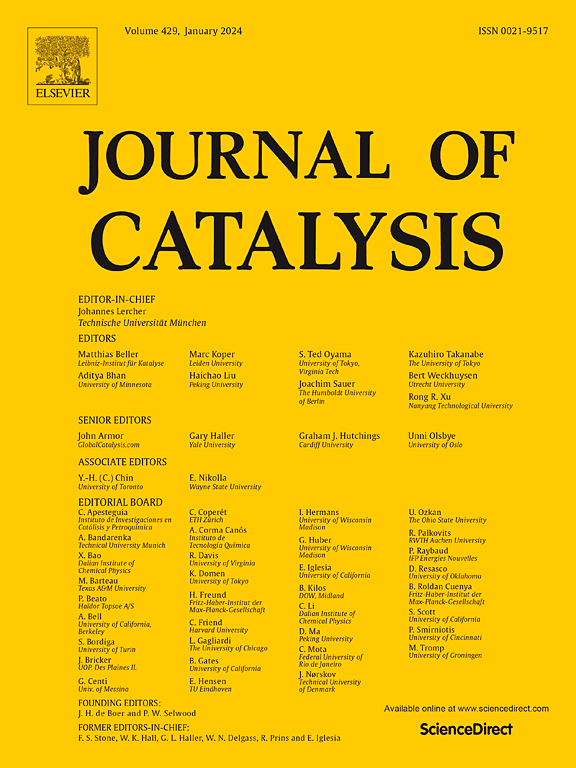揭示量子点中双杂原子掺杂剂促进光催化CO2还原的协同作用
IF 6.5
1区 化学
Q2 CHEMISTRY, PHYSICAL
引用次数: 0
摘要
杂原子掺杂半导体量子点(QDs)已成为调整其电子结构和提高其光催化活性的重要技术手段。然而,由此产生的系统仍然存在光催化CO2还原效率低的问题。本文报道了Se2-和Ga3+共掺杂CdS量子点可以促进光催化CO2还原。在Ga/Se共掺杂的CdS量子点上获得的CO析出速率几乎是原始CdS量子点的20倍,也高于其他一些基于量子点的CO2光还原光催化剂。机理研究发现,在CdS量子点中共掺杂Se和Ga可以抑制光生电子-空穴对的重组,降低促进CO2转化为CO的关键*COOH中间体的形成势垒。本文章由计算机程序翻译,如有差异,请以英文原文为准。


Unraveling the synergy of dual heteroatom dopants in quantum dots for boosting photocatalytic CO2 reduction
Doping semiconductor quantum dots (QDs) with heteroatoms has emerged as a technologically important tool for tuning their electronic structure and improving their photocatalytic activities; however, the resulting systems still suffer from low efficiency towards photocatalytic CO2 reduction. Herein, we report that co-doping CdS QDs with Se2- and Ga3+ can boost the photocatalytic CO2 reduction. The achieved CO evolution rate over Ga/Se co-doped CdS QDs is almost 20 times higher than that of pristine CdS QDs, and is also higher than some other reported QDs based photocatalysts for CO2 photoreduction. The mechanism study uncovers that the co-doping of Se and Ga in CdS QDs can suppress the recombination of photogenerated electron–hole pairs and decrease the formation barrier of the key *COOH intermediate for promoting the CO2 to CO conversion.
求助全文
通过发布文献求助,成功后即可免费获取论文全文。
去求助
来源期刊

Journal of Catalysis
工程技术-工程:化工
CiteScore
12.30
自引率
5.50%
发文量
447
审稿时长
31 days
期刊介绍:
The Journal of Catalysis publishes scholarly articles on both heterogeneous and homogeneous catalysis, covering a wide range of chemical transformations. These include various types of catalysis, such as those mediated by photons, plasmons, and electrons. The focus of the studies is to understand the relationship between catalytic function and the underlying chemical properties of surfaces and metal complexes.
The articles in the journal offer innovative concepts and explore the synthesis and kinetics of inorganic solids and homogeneous complexes. Furthermore, they discuss spectroscopic techniques for characterizing catalysts, investigate the interaction of probes and reacting species with catalysts, and employ theoretical methods.
The research presented in the journal should have direct relevance to the field of catalytic processes, addressing either fundamental aspects or applications of catalysis.
 求助内容:
求助内容: 应助结果提醒方式:
应助结果提醒方式:


